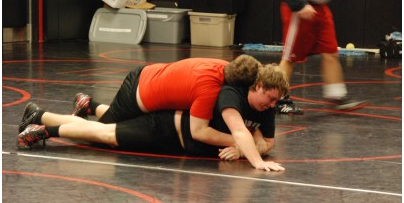Safe weight
How the UIL keeps wrestlers healthy

The state has created ways to ensure that wrestlers cut weight in a healthy manner.
January 14, 2015
Winning matches is important, but a wrestler will never compete if their desired weight is not maintained. However, cutting too much weight can be unhealthy so the UIL has devised a method that ensures that every wrestler maintains a healthy weight.
“Wrestling has done a weight certification process where one, they have to be hydrated,” head wrestling coach Mike Eaton said. “It’s a body fat analysis and hydration test.”
The first test is a simple hydration test that is done by examining each wrestler’s urine.
“The most rudimentary way to do it is they have to basically show they are hydrated by just looking at their urine,” Eaton said. “So what that does is it stops wrestlers from starving themselves or cutting weight for that certification.”
The second test is a body fat analysis test.
“[The body fat test] can be done several ways,” Eaton said. “The way we do it is calibers. They are taking skinfold measurements. For the men they take them on three spots: your triceps, your subscap, and your abdomen. For women just the triceps and subscap. So what they are doing is measuring body fat.”
The reasoning behind this test is to get a baseline weight for the remainder of the wrestling season.
“What the state of Texas does is once your body fat is analyzed, they will not let you go under seven percent body fat (12 percent for women),” Eaton said. “So, if you have under seven percent body fat you can not wrestle any lower than the weight you are at that first day when you get this test done.”
If wrestlers desire to move down in a weight class, they are required to lose the weight progressively instead of losing extreme amounts of weight in short amounts of time.
“If you are cutting weight it takes a lot of effort to get your weight down,” junior Bo Beidleman said. “You may have to go to practice, and then go to the gym afterwards. Eating clean is the biggest part. Once you do that it gets a lot easier, but usually cutting a weight class takes a couple of weeks.”
UIL also regulates the amount of weight a wrestler can lose per week.
“The rules say that you can not lose more than one and a half percent of that (starting) weight per week.” Eaton said.
For instance, if a wrestler was 200 pounds, they could not lose more than 1.5 pounds a week until they get to the seven or twelve percent body fat. At that point they should not lose any more weight.
“So, what that does is it stops people from yo-yo dieting,” Eaton said. “It stops people from going down three pounds in a night and then the next week they are up five pounds.”
The reason that weight management is so highly regulated is because it is such an important part of wrestling.
“Managing your weight is important because if you’re not at the top weight your weight class allows you to be, then you can be at a disadvantage when you wrestle,” junior Logan Hunble said. “The other guy could be stronger or bigger than you just because he weighs a little more.”




